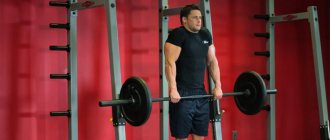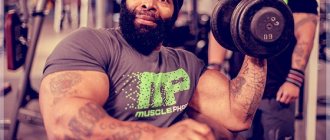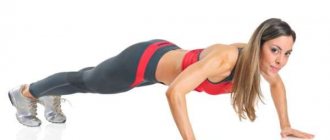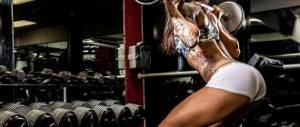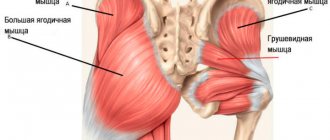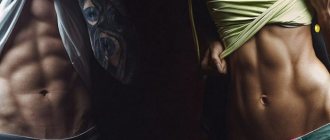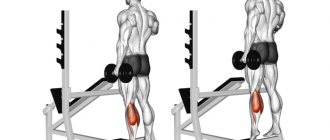The buttocks are a rather controversial part for athletes. Many professional bodybuilders work on high-quality drying with weight gain, constantly measuring the volume of their hips. Beach bodybuilders (crossfitters, weightlifters) and fitnessists, on the contrary, try to exclude these muscle groups from their work as much as possible. And only women, inspired by the successes of Kim Kardashian, strive to increase their muscles in a specific area as much as possible. For this purpose, it is best to use exercises for the buttocks with dumbbells or other weights. Why not simple squats and running? Muscle growth requires constant stress. In particular, light and bodyweight exercises do not place sufficient stress on a fairly large muscle group.
How to select loads?
Before considering programs and exercises for working the buttocks, you need to decide what weight will be used during the exercises. It will come as a shock to many, but the dumbbells and barbells used to shape the buttocks should significantly exceed women's expectations of the maximum weight they can lift. Why? Everything is very simple - this is a very powerful muscle group, which is actually responsible for holding the entire body (from 50 kilograms) throughout the day, and in order to shock them, proportional loads are needed.
Particularly effective for women are exercises for the buttocks with dumbbells with heavy weights, which are needed to sufficiently work the buttocks, reduce the percentage of fat and increase muscle mass. In particular, squats, lunges and a farmer's walk with wide strides are performed with a weight of at least 20 kilograms. But for many, this turns out to be quite a strong overload and the body cannot cope. What to do in this case? Unfortunately, with all the desire to work exclusively on the gluteal leg, as in any other case, you will need to spend a preparatory month, and perhaps more than one, after which the body will get used to working with iron.
The preparation month looks like this:
- training at least 3 times a week;
- working with basic exercises (pull-ups, push-ups, squats), with moderate weights (empty bar) to master the technique.
- use of block simulators;
- active training of the lumbar region with massive hyperextensions with a barbell plate.
Don’t worry, during this month you won’t turn into Schwarzenegger; moreover, external changes in your figure will be almost unnoticeable, but in the future, when working with heavy weights during squats and lunges, they won’t become an opportunity to get a lower back injury, sprain, or overtraining of the body. If you are looking for good and effective exercises for the buttocks with dumbbells at home, then similar training with deadlifts, squats and push-ups can be done at home.
Exercises
Now that you know how to choose the right loads, and that you will have to train hard, you can begin to consider the most effective solutions for pumping up the buttocks. The list of exercises is quite large, but this does not mean that all of them need to be performed in one day:
- dumbbell plie;
- squats with wide legs;
- deep squats;
- lunges;
- farmer's walk with long strides;
- deadlift (bending forward with dumbbells).
Let's look at how it works and how to do each of them correctly.
There is another exercise - this is the gluteal bridge. This is an extremely difficult exercise that requires a barbell or Smith bench. At the same time, its effectiveness is extremely low, and the slightest violation of the technique can have a very bad effect on the overall health.
Dumbbell plie
The dumbbell plie is the first basic dumbbell exercise for the buttocks and thighs. It almost completely disables the quadriceps from working. In this case, the entire emphasis shifts exclusively to the gluteal muscles. If your goal is exceptionally beautiful legs, thighs and firm buttocks, you won’t be able to do without it.
How to do it?
- Spread your legs as wide as possible.
- Socks point to the sides.
- Bend your back.
- The head looks straight ahead. If this is difficult, you can look up, but not down.
- Dumbbell – weighing up to 15 kg (for beginners, the optimal weight is 5-8 kg), located in the hands, between the legs.
- Squat down as deeply as possible, while maintaining an arch in your back.
- Fix at the lowest point for 1-2 seconds.
- Get up.
If you have a mirror, looking into it you should see movements very similar to how sumo wrestlers take the starting position before a match.
Wide Leg Squats
This exercise with dumbbells for the buttocks is more suitable for losing weight than for pumping up muscles. Despite its anaerobic nature, it involves all major muscle groups, due to which calorie content and energy consumption during the approach increase several times. All this leads to a calorie deficit and weight loss. From the point of view of using the buttocks, here, depending on the placement of the heels, the load may shift slightly to the front of the legs, which will allow them to be tightened, but in general the load falls on the back of the legs.
How to do it correctly?
- For squats with deep legs, you will need 2 heavy dumbbells (weighing 5 kg or more).
Then there are two techniques. With dumbbells placed on your shoulders (like weight lifters), or the ability to place them crosswise on your chest (Coleman technique).
- Dumbbells are placed in their starting position.
- Legs are placed 1 foot wider than shoulder width on each side
- Bend your back.
- The head looks straight ahead. If this is difficult, you can look up, but not down.
- Squat down as deeply as possible, while maintaining an arch in your back.
- Fix at the lowest point for 1-2 seconds.
- Get up.
The technique is very similar to plie, but, unlike the previous exercise with dumbbells for the buttocks and legs, this is somewhat more difficult to perform. In addition, the load is much stronger. The main difference and emphasis in the work occurs solely due to changes in the placement of the legs.
Deep squats
This exercise came into home workouts from classical physical education. At the same time, many underestimate its power, or simply do it incorrectly.
So, let's look at the technique:
- The dumbbells are placed in the starting position, similar to the previous exercise.
- Feet become shoulder-width apart.
- There is a strong arch in the back.
- Head straight ahead.
- Next you need to start moving your hips back. That is, do not bend your knees, but tilt your body back and make a maximum descent, simultaneously bending your legs.
- Fix at the lowest point for 1-2 seconds.
- Get up.
To emphasize the load, you can place small wooden planks up to 10 centimeters thick under the socks. To remove emphasis, these same boards can be placed under the heels.
It is due to this movement that the load falls entirely on the gluteal muscles, bypassing the quadriceps. If you need to change the load on the contrary, remove the tilt of the body back and keep your back completely straight
Lunges
The next exercise seems extremely simple, until you start doing it. Yes, yes, these are lunges with dumbbells, which, unlike the previous ones, are an isolating exercise. What does it mean? That's right, that exclusively the gluteal muscles and the back of the thigh are involved. The quadriceps, calves and back muscles serve exclusively as stabilizers.
How to do it correctly?
- Dumbbells are placed on the shoulders.
- One leg is placed as wide forward as possible.
- Next, bend your back
- Stretch towards your leg (make maximum emphasis).
- Make 2-3 springing movements.
- Change leg.
In total, this should be done 7-12 circles on each leg. The optimal weight for beginners is 5-8 kg each dumbbell.
Farmer's Walk with Long Steps
The farmer's walk with a wide stride is a more dynamic technique of the previous exercise. The main difference starts from the 5th point of movement. Namely, instead of just changing legs. From the lunge position, you need to move your back leg forward and lunge onto it. To visualize this movement easier, imagine that you are simply walking very wide, carrying bags of food in your hands. Although the position of the dumbbells plays an important role, since much larger equipment is used in the walk, the main recommendation would be to change their position. Those. can be held as during Plie.
Deadlift (forward bends with dumbbells)
This exercise is actively used in powerlifting, and even experienced athletes cannot always perform it correctly. But at the same time, of all of the above, it puts the greatest load on the back of the thigh, back muscles (responsible for posture), and most importantly, on the gluteal muscles.
How to perform a deadlift correctly?
- Dumbbells are picked up.
- Feet are placed shoulder width apart.
- The arch in the back remains
- The head looks ahead.
- Start moving downwards, keeping your back arched and your legs as straight as possible.
- At the lowest point, try to touch the floor (if stretching allows).
- Carefully rise from the lower phase, maintaining the deflection.
Advantages of projectiles
Agree, with the help of simple dumbbells you can “load” and make work, if not all, then certainly a huge number of muscles. It is difficult to list absolutely all the exercises that can be performed using such sports equipment.
Dumbbells are very convenient because they can be used both in the gym and at home. This explains their high popularity among home workout enthusiasts.
Today, you can find a variety of projectile options on the sporting goods market. An important option that significantly affects the price of the product is the ability to adjust the weight. Collapsible dumbbells are much more expensive than simple ones.
Thanks to this, absolutely everyone can train with them, regardless of gender or age. If you are a beginner athlete, then set the weight light. And, if you have good physical training, then throw a couple of pancakes and you can start training.
In this article you will not find difficult and impossible actions with dumbbells. But some of them require a bench or chair.
How to train?
How to train your gluteal muscles. There are slightly different recommendations for men and women in this regard. First you need to set a common goal:
- gaining muscle mass in the indicated areas;
- toning muscles;
- using the buttocks as the basis for basic growth.
Depending on this, the training program will differ radically. Women often want to get bigger and firmer buttocks. In this case, for good pumping, it is recommended to use a two-day split. In which the emphasis will be on basic muscle work with squats in each workout, the remaining muscles are worked on the second day of the split. If you just need to tone your muscles with exercises for the buttocks with dumbbells, then it is better to use frequent loads (up to daily), with light weights and long approaches (20-30 times per exercise). This will help tone both the skin and muscles. But it should be remembered that with this approach, you should never skip scheduled classes, otherwise the entire effect may come to naught. And, if exercises for the buttocks with dumbbells are used as an addition to the basic ones, then an approximate workout should look like this:
- basic squat;
- 1-2 exercises from those previously indicated.
You need to work under the maximum possible load, using the maximum possible working weights. In this case, for successful growth, it is not recommended to load the muscles of the buttocks more than once every 7-10 days. It is better to devote the remaining training days to basic exercises for other muscle groups.
Muscle atlas: which muscles work?
Anatomically, when the body is tilted to the side (as shown in the figure), the work involves the serratus anterior muscle, external oblique muscle, rectus muscle and internal oblique muscle. All of these muscles are located in the abdominal area, that is, under the pectoral muscles. Some stress is also placed on the lower back muscles, which emphasizes the importance of proper technique.
Muscles that work during the exercise
By performing the exercise, the athlete works those muscles that will subsequently determine the appearance of the waist and abdomen. However, it is necessary to understand that with a significant fat layer, the development of these muscles will not be noticeable, which will negate any attempts to make this area expressive and prominent.
Programs
A complete set of exercises with dumbbells for the buttocks looks something like this:
| Exercise | Approaches | Repetitions |
| Dumbbell plie | 5 | 20 in each approach |
| Deadlift (forward bends with dumbbells) | 3 | 12 in each set |
| Farmer's Walk with Long Steps | 1 | 30-50 steps |
| Lunges | 5 | 12 per leg per set |
| Deep squats | 3 | 7 in each approach |
| Wide Leg Squats | 5 | 5 in each approach |
Bottom line
Working out target areas using effective exercises for the buttocks with dumbbells allows you to quickly get the coveted shape.
Still, there are two main points:
- If you are trying to lose weight, it is better to use other complexes that include the active use of cardio exercises. It is impossible to burn fat and build a beautiful, firm butt at the same time.
- If the exercise technique is incorrect, everything will sway except the buttocks themselves.
Well, and most importantly, even if you want to train at home, it is better to spend another month at the gym, where you can definitely and accurately receive corrections in your technique under the supervision of an instructor.
Secrets of proper technique
When performing the exercise, you should be guided by a number of principles:
- It is necessary to warm up before performing the exercise. Particular attention should be paid to the lower back.
- It's worth starting with a little weight. It is recommended to use a dumbbell weighing 3–5 kilograms, gradually increasing the load.
- The exercise is most effective when combined with other movements.
- If you use heavy weights and low repetitions, you can achieve larger abs and obliques, which will widen your waist.
- If you have problems with the spine, then it is better to refuse to perform bends with a dumbbell.
- When losing weight, a multi-repetition version of the exercise is recommended; particular effectiveness is observed when the movement is included in supersets.
The main point is compliance with the exercise technique. If you have questions, it is better to contact a trainer or study additional materials online.
You can also use a kettlebell as a weight, but the minimum weight of a kettlebell is usually 16 kilograms, so it’s better to pay attention to dumbbells first.
